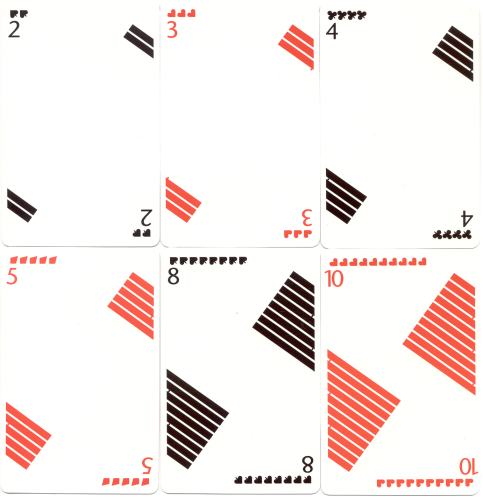
Analog by RUTH KEDAR
On the numbercards one can use the indices, but also the number of suits symbols in the top line or the number of -black or red- diagonal lines indicate the card's value.

|
|
Artists are creative beings. Ruth Kedar is not the first artist who has designed her own box to store her decks in, but both the boxes for the Analog and Duolog deck are examples of ingenious, yet practical design. The used material for the Analog box feels a bit like linen structured playing card carton. The Queen of Hearts, the title and a small diamond suitsign are embossed and printed in red. On the flap that forms the second inside cover there's an informative text about the how and why of the Analog deck. The exact text is given here below. It's impossible to assemble these boxes automaticly or mecanically, so each box must have been assembled by hand, before the decks could be added. But once assembled, then it makes a sturdy box, that opens and closes easily. |
|
|
|
As Ruth says........
"Playing Cards is a fascinating subject. They are
surrounded by mystique and for centuries people have lived and died byy them.
The research involved in designing a deck of cards has not succeeded in shedding
the mystique - instead it inspired the imagination and opened new avenues of
thought. Those blossomed into innovative contemporary designs that are strongly
limited to tradition on one hand and break through convention on the
other.
ANALOG brings to playing cards a visual language in which their value is
quantative and palpable - they are iconographic in nature and their value is not
merely an appendix but rather an integral part of the design itself. This visual
language accentuates the changes and nuances during play and the total is
greater than the sum of its parts.
History and symbolisme are represented
through modern graphics - the figures emerge from the analog indexing system and
all their garments including crowns are generated by the individual suit symbol.
The pattern design on the backs creates a magical feel of continuity as the game
progresses and at the same time provides an indication to the front's visual
imagery. In different games the fanning and stacking of the cards provide
visuals that are unique and ever changing"